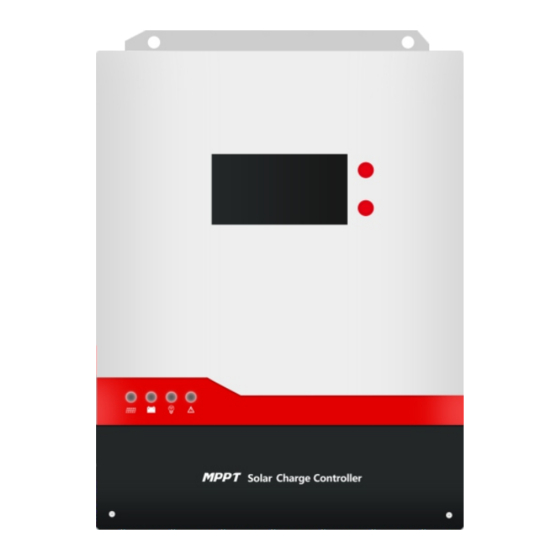
Table of Contents
Advertisement
Quick Links
Advertisement
Table of Contents

Summary of Contents for MPPT 104714
- Page 1 MPPT Solar Charge and Discharge Controller User Manual Mode:104714...
-
Page 2: Table Of Contents
Thank you very much for choosing our product! 1.1.Overview 1.2.Features 1.3.Appearance and Interfaces 2、 MPPT Technique Introduction Safety Instructions 3、 Technical Parameters 4、 Battery Charge 1) The applicable voltage of the controller exceeds the human safety voltage. Please read the user 4.1Lead-acid battery charge... -
Page 3: 1、 Product Introduction
The controller employs the industry-leading PowerCatcher maximum power point tracking technique to track the maximum energy of the solar panel. The MPPT technique enables the controller to quickly and accurately track the maximum power point of the solar panel in any environment and obtain the maximum ⑬... -
Page 4: 3、 Technical Parameters
The maximum power point often changes due to different ambient temperature and lighting Light control OFF voltage conditions. Our MPPT controller can adjust the parameters from time to time according to different 6V*n conditions, so that the system is always near the maximum power point. The entire process is completely... -
Page 5: 4、 Battery Charge
The parameters of lead-acid batteries listed in the table are those of the 12V system at 25℃; for 24V/36V/48V In the MPPT charge stage, the battery voltage has not yet reached the target constant value, and the battery systems, they should be multiplied by 2/3/4. -
Page 6: 5、 System Settings
Charging current Charging current Fast charging Sustaining 5.2 Lithium battery application Floating charging Fast Sustaining charging Equalizing charging voltage charging charging Boost Boost charging voltage Method 1: Select “LI” as the battery type, and the default is lithium iron phosphate battery. Floating charging voltage Method 2: Either Lead-acid battery or Lithium battery may be used in USE mode, so the following Charging return voltage... -
Page 7: Load Output
Indicator status Charging state circuit protection. MPPT charge Steady on 1. Setting method: 1) Press the “SELECT” button to switch the menus to load mode interface;... -
Page 8: Battery Indicator
Turn off load output Load over current Delay to turn off load at multiples of rated current The internal temperature of controller is too high, MPPT controller starts charging with reduced power; when the Controller internal over temperature temperature is below a certain value, charging automatically... -
Page 9: 11、Common Troubles And Handling Methods
Battery discharge high temperature 12. Product Installation Turn off load output protection Battery discharge low temperature Turn off load output protection 12.1 Installation considerations Overcharge protection Turn off charging Battery charge low temperature Be very careful when installing the battery, and wear protective goggles when installing FLD lead-acid Turn off charging protection battery. -
Page 10: 14、System Maintenance
PV input terminal over voltage 16. System Wiring Diagram When the voltage at the PV array input terminal is too high, the controller will automatically cut off the PV input. PV input reverse polarity protection When the polarity of the PV array is reversed, the controller will not be damaged. After correcting the 16.1 Stand-alone application wiring error, it will continue to work properly.












Need help?
Do you have a question about the 104714 and is the answer not in the manual?
Questions and answers